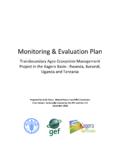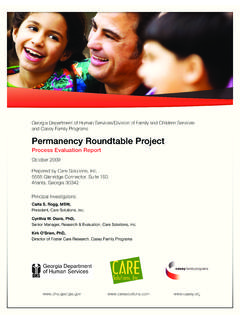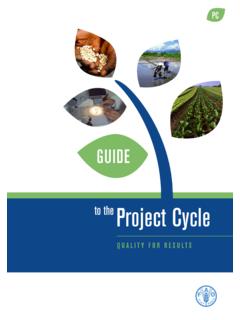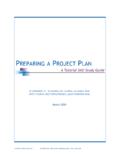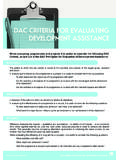Transcription of Copyright for Project Evaluation Guide For Nonprofit ...
1 We would like to hear from you. Please send your comments about this Guide to Thank you. 2006 Imagine Canada Copyright for Project Evaluation Guide For Nonpro t Organizations: Fundamental Methods and Steps For Conducting Project Evaluation is waived for charitable and nonpro t organizations for non-commercial use. Such organizations are encouraged to copy and distribute this material. Imagine Canada Imagine Canada Ottawa Imagine Canada Calgary 425 University Avenue, Suite 900 1705 130 Albert Street 1800 855 2nd St. SW, Toronto, Ontario M5G 1T6 Ottawa, Ontario East Tower, Bankers Hall, Tel.: (416) 597-2293 K1P 5G4 Calgary, Alberta Toll free: 1-800-263-1178 Tel.: (613) 238-7555 T2P 2S5. Tel.: 1-800-821-8814 Tel.: (403)645-3086. ISBN 1-55401-315-1. We acknowledge the nancial support of the Government of Canada through the Department of Canadian Heritage. The opinions expressed in this publication do not necessarily re ect those of the Department of Canadian Heritage.
2 TABLE OF CONTENTS. ABOUT THIS Guide III. INTRODUCTION IV. MODULE ONE: CREATING AN Evaluation PLAN 1. Writing a Project Description 2. Stating an Evaluation Purpose 3. Identifying Evaluation Stakeholders 5. Selecting Evaluation Types 6. Choosing Evaluation Questions 9. Choosing Evaluation Tools 12. Identifying Evaluation Sources 15. Identifying Evaluation Budgets 15. Completing This Module 18. MODULE TWO: IMPLEMENTING YOUR Evaluation PLAN 19. Engaging an Evaluation Group 20. Assembling Skilled Staff 21. Increasing Organizational Support 22. Understanding Ethical Conduct for Evaluations 23. Using Your Evaluation Plan 24. Identifying Evaluation Indicators 25. Monitoring Your Project 29. Finding Existing Information and Tools 29. Developing Evaluation Tools 31. Managing Data Collection 32. Completing This Module 34. MODULE THREE: ANALYZING AND INTERPRETING DATA 35. Understanding Types of Data 36. Preparing Data for Analysis 37.
3 Checking Data Accuracy 39. Analyzing Data 42. Interpreting Results 44. Completing This Module 46. MODULE FOUR: COMMUNICATING Evaluation RESULTS 47. Preparing Reports 49. Presenting Results in Person 51. Using the Media to Communicate Results 52. Completing This Module 53. GLOSSARY 54. REFERENCES & SUGGESTED READING MATERIALS 56. APPENDIX 1: TEMPLATE FOR Evaluation TOOLS (MATRIX) 59. APPENDIX 2: TEMPLATE FOR Evaluation BUDGET 60. APPENDIX 3: TEMPLATE FOR Evaluation PLAN 61. APPENDIX 4: TEMPLATES FOR MONITORING Project ACTIVITIES 65. APPENDIX 5: TIP SHEETS ON RESEARCH METHODS AND TOOLS 67. I APPENDIX 6: Evaluation REPORT TEMPLATE 83. Project Evaluation Guide ACKNOWLEDGEMENTS. The author would like to thank the following individuals for their assistance with this work. At Imagine Canada, Michael Hall, Cathy Barr, and M. Easwaramoorthy provided advice and comments on earlier drafts of this tool, which signi cantly improved it.
4 At Volunteer Canada, Ruth MacKenzie and Kym Shouldice reviewed this tool and provided valuable comments. This work was made possible by the staff and volunteers of the organizations that received funding from the Community Support Centre, who were willing to learn about Evaluation and tested various parts of this Guide . In addition to these Community Support Centre-funded organizations that shared their Evaluation experiences over the last three years, I would like to thank the following organizations whose reports were used to prepare the exhibits found in this tool: University of Regina Seniors' Education Centre, Saskatchewan Heartwood Centre for Community Youth Development, Halifax, Nova Scotia Canadian Cancer Society (CCS) PEI Division Yukon Learn Society The Boys and Girls Club of Niagara, Ontario Canadian Red Cross Newfoundland and Labrador The Canada Volunteerism Initiative (CVI) of the Department of Canadian Heritage, through the Community Support Centre, provided funding for the development of this Guide .
5 II. Imagine Canada 2006. ABOUT THIS Guide . This Guide is designed to assist charitable and nonpro t organizations to conduct precise and appropriate Project evaluations, and then communicate and use the results of Evaluation effectively. Its primary focus is to help organizations that would like to perform Project evaluations by using their internal resources, and to make Evaluation a part of their Project management and strategic development. The Guide is the result of three years of work with charitable and nonpro t organizations across Canada with the purpose to evaluate a wide variety of community-based projects funded by the Community Support Centre, a part of the Canada Volunteerism Initiative (CVI). Most of the forms and templates included here were initially used by these organizations and then, based on their feedback, revised for this Guide . The four training modules that are described in this Guide contain the essential information and steps to complete any type of Project Evaluation .
6 They are: Module One, which explains all steps you need to create an Evaluation plan. Module Two, which focuses on how you can implement the Evaluation plan and gather Evaluation data. Module Three, which explains data analysis and interpretation of results. Module Four, which provides suggestions for communicating the Evaluation results. Although you can use these four modules in any Project Evaluation , you may need to adjust the steps and details for each Evaluation depending on the type of Evaluation you require and the context, budget, and time frame of your Project . For example, you can review the planning section (Module One) to obtain a clear understanding of the context, goals, and background of the Project you want to evaluate, and the needs and purposes for Evaluation . Based on your work in this module, you can review the other steps in this Guide and determine the ones that are applicable to your Project , the ones that need further modi cations and revisions, and the ones you can skip.
7 For more information, see the References and Suggested Reading Materials. Most of the terms that are in italic type are de ned in the Glossary. This Guide is prepared for staff and internal evaluators. Some sections may not be applicable for external evaluators and contractors. III. Project Evaluation Guide INTRODUCTION. Evaluation is an important tool that your organization can use to demonstrate its accountability, improve its performance, increase its abilities for obtaining funds or future planning, and ful ll the organizational objectives. By communicating the results of the Evaluation , your organization can inform its staff, board of directors, service users, funders, the public, or other stakeholders about the bene ts and effectiveness of your organization's services and programs, and explain how charities work and how they are monitored. Although there are many bene ts in conducting Evaluation , it will be a waste of your organization's resources if the Evaluation results are not used.
8 The purpose of Evaluation is to provide information for actions such as decision-making, strategic planning, reporting, or program modi cation. Project Evaluation helps you understand the progress, success, and effectiveness of a Project . It provides you with a comprehensive description of a Project , including insight on the needs your Project will address;. people who need to get involved in your Project ;. de nition of success for your Project ;. outputs and immediate results that you could expect;. outcomes your Project is intended to achieve;. activities needed to meet the outcomes; and alignment and relationships between your activities and outcomes. Evaluation is a systematic investigation of the worth or signi cance of an Evaluation normally involves some standards, criteria, measures of success, or objectives that describe the value of the object. Evaluation can identify criteria for success, lessons to learn, things to achieve, ways to improve the work, and the means to move forward.
9 Project Evaluation assesses activities that are designed to perform a speci ed task in a speci c period of time. For example, a three-day workshop on volunteerism, a one-year fundraising program, a three-year HIV prevention intervention, a ve-year career development innovation, or an ongoing newcomer youth orientation and integration training program are all projects that you can evaluate. 1 Scriven, M. 1991. IV. Imagine Canada 2006. INTRODUCTION. Project Evaluation and Project management are interrelated. Evaluation can help you complete a Project successfully, provide evidence of successes or failures, suggest ways for improvements, and inform decisions about the future of current and planned projects. Project Evaluation is an accountability function. By evaluating a Project , you monitor the process to ensure that appropriate procedures are in place for completing the Project on time, and you identify and measure the outcomes to ensure the effectiveness and achievements of the Project .
10 All these efforts make your organization capable of reporting, answering all inquiries, and being accountable for its You can use the results of a Project Evaluation to identify ways to improve or shift your Project activities;. facilitate changes in the Project plan;. prepare Project reports ( , mid-term reports, nal reports);. inform internal and external stakeholders about the Project ;. plan for the sustainability of the Project ;. learn more about the environment in which the Project is being or has been carried out;. learn more about the target population of the Project ;. present the worth and value of the Project to stakeholders and the public;. plan for other projects;. compare projects to plan for their futures;. make evidence-based organizational decisions;. demonstrate your organization's ability in performing evaluations when searching for funds; and demonstrate your organization's concerns to be accountable for implementing its plans, pursuing its goals, and measuring its outcomes.













